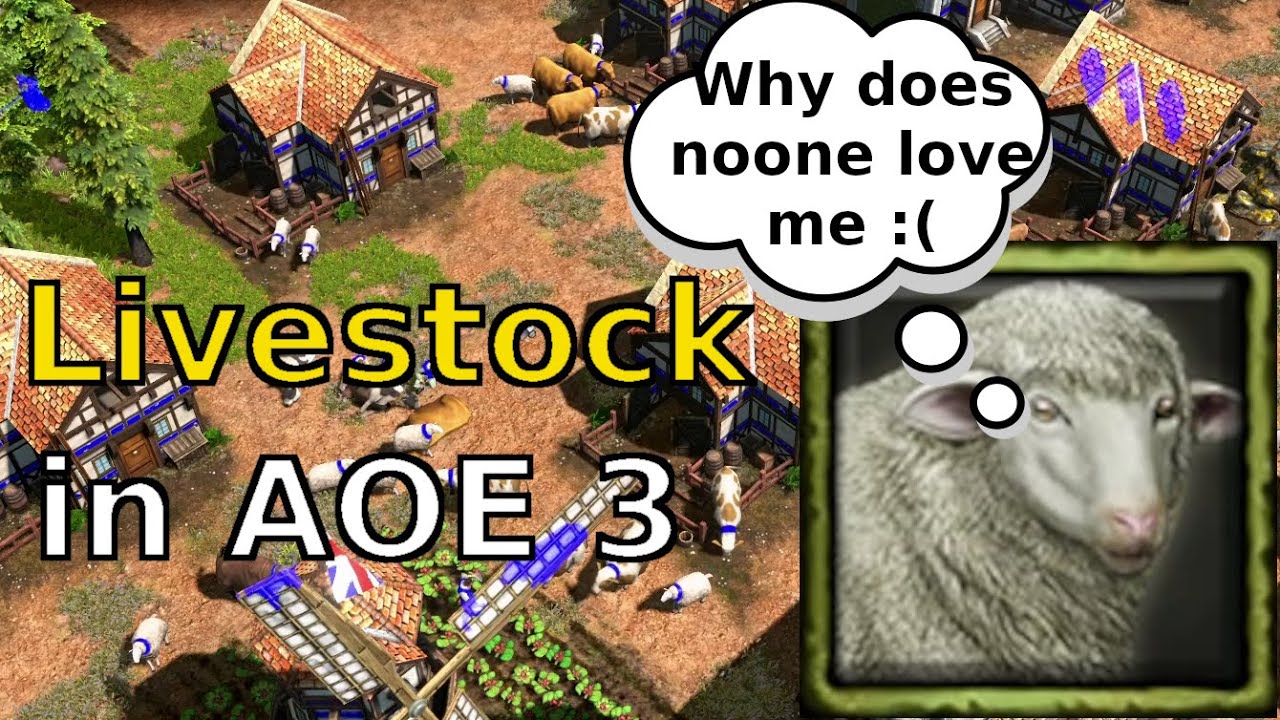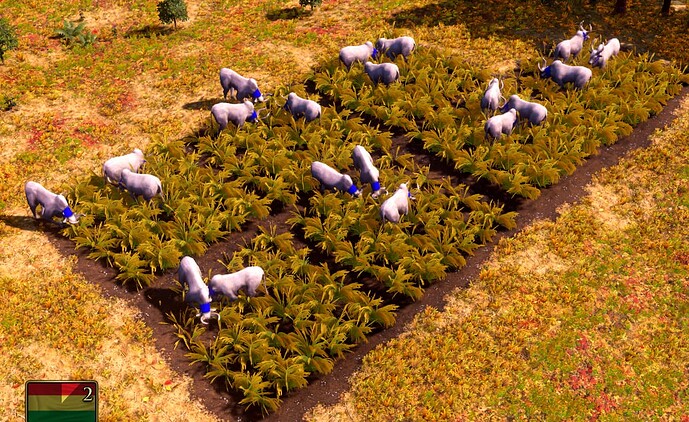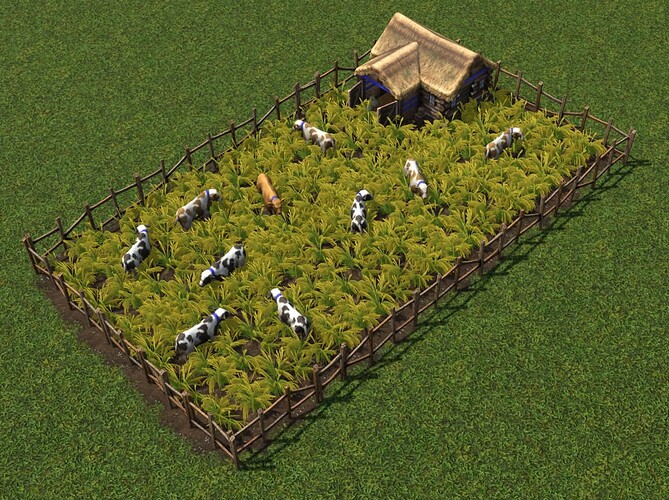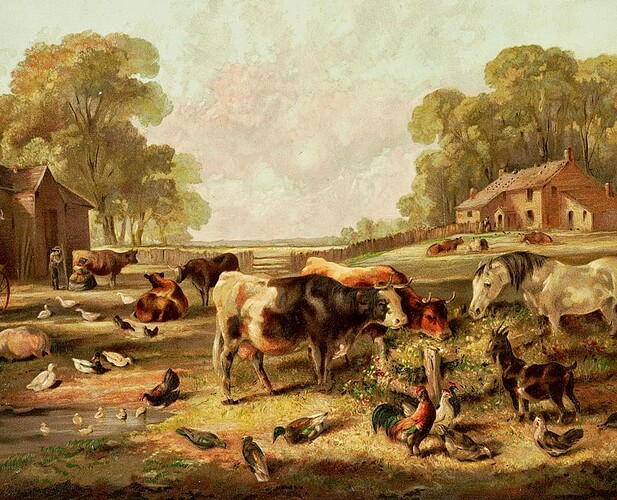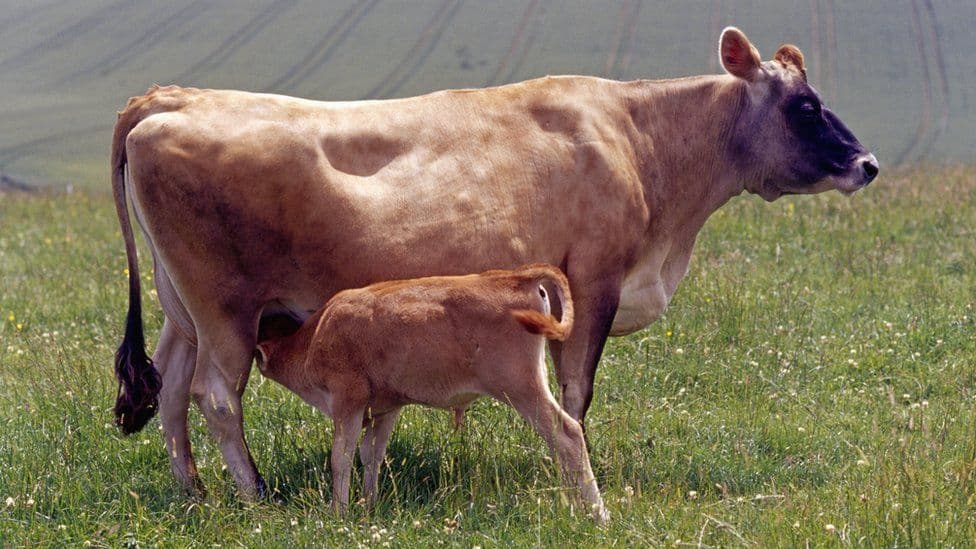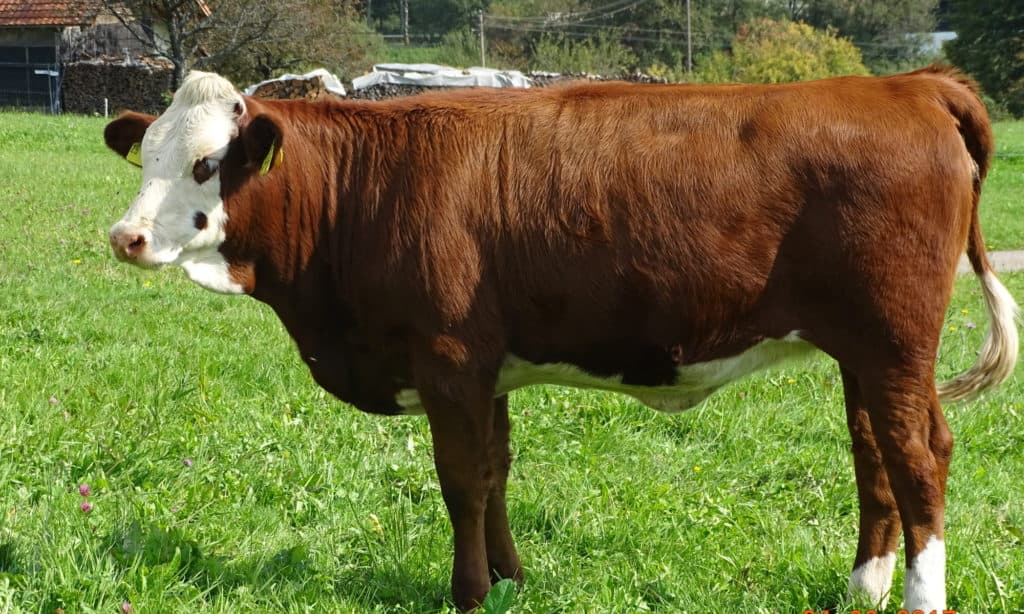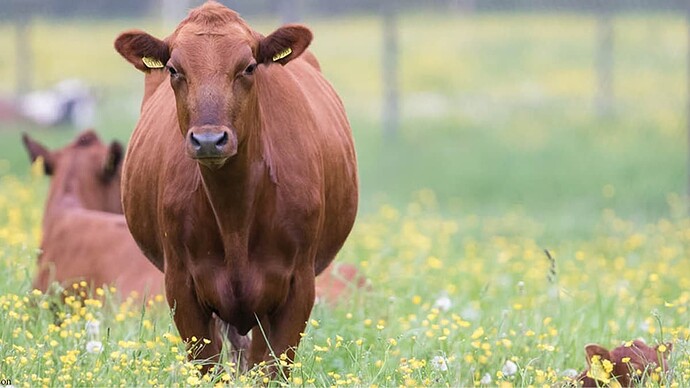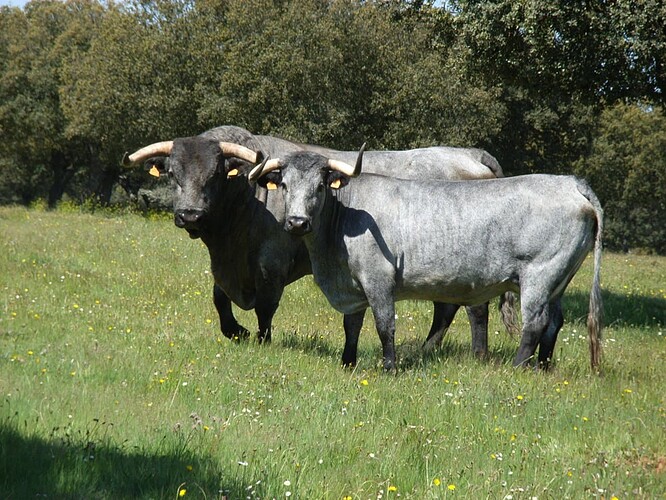Prologue:
Note: It is important that you read so that you do not miss the details, but if you want to get to the point, start reading in ‘General concept of mechanics’ and below ‘Artistic concept and gameplay.’.
Next I will present a complex idea about what I consider necessary for the usefulness and biability of European cattle to be as practical to use as African cattle are now.
I had made some proposals related to this aspect of the game in other forums and my proposal seems to have been liked a lot, but it was only the general idea without going into depth.
I have thought a lot about how to turn it into a feasible, practical and realistic economic mechanic without breaking the balance of the game and that is why I did not present it before, because it is not so easy to put it on the table.
Having seen that Africans have their own breed of cattle according to their region and their inherent qualities, I thought, why not do the same with European cattle, which are so diverse? Why not make it useful from the beginning and not just wait for them to get fat?
Livestock has always been key to many civilizations throughout its history (Livestock are animals such as: bovines, sheep, goats, horses, pigs and others) so it deserves more prominence in the game.
What I will propose is intended to be unique to each civilization and add a new level of strategic depth to the game. So let’s get started!
Here is a video that better explains the current situation of livestock:
General concept of the mechanics
Bovine cattle:
As I already mentioned, European cattle can only be fattened, and waiting for that to happen because of the general is not feasible for how hasty the supremacy usually is. For this reason, I propose to give reel cattle greater versatility in the following way:
Cows could have a dual purpose (milk and meat). In other words, they can get fat as has been traditionally done or they can generate a constant drip of food, making cattle a renewable resource.
Sheep cattle:
It is the cattle that Europeans start with by default. Basically they are the same in terms of biability, that is, very little feasible in immediate use and it is only really useful if the map grants the animals such as the mongolia map or the texas map. In this case the sheeps would produce wool, which would be translated into coins.
Collection method.
Of course the traditional way of fattening animals will not be replaced. But if you opt for the aforementioned forms of production, the animals will not get fat.
For animals to produce a constant trickle of food or money, they require a small reinvestment every set amount of time. This aims to simulate the inputs that real life livestock requires to achieve optimal productions, and at the same time it aims to give a balance between investment and profit so that somehow there is a balance in which it is not a simplistic economic form and has certain complexity. (Similar to replanting farms in AOE-1 and AOE-2).
A villager will be in charge of extracting the milk from the cows, and the wool from the sheep. One villager for every 10 cows and one villager for every 15 sheep.
Theoretical and mathematical concept:
¡This is the hard part!.
I have thought for a long time to come up with a workable way to implement this new mode in a way that is compatible with the way the game conducts the economy of different civilizations. Luckily there is already a base on which to lean on and it is African cattle, so below I will expose the methods I use so that it somehow resembles the way African cattle work, but at the same time trying to be very different.
For cows. 
Based on African cattle, their base influence collection rate is 0.15 / s, which is 0.1875 / s in feed (1 influence = 1.25 in feed). And if he uses the “draft oxen” card, he will collect 0.25 / s of food. If we add both values (0.1875 + 0.25) it would be equal to 0.4375 / s in food.
So this will be the base value (0.4375 / s) that I will use for European cattle food production.
If we assume that we have 2 pens in production with 10 cows each, it would be a total of 8.75 / s in feed, or 525 / m in feed.
Another factor that I took into account is its harvesting efficiency in agriculture, where Africans are a bit inferior to give economic prominence to livestock. Villagers collect 0.55 / s from fields when they have a barn nearby. European workers collect 0.67 / s from the mills. This is a difference of 0.12 / s of food.
So this difference (0.12 / s) is what I will use for the periodic reinvestment mechanic in the pens every 5 minutes of play in case the pens are at full capacity (10 cows), which would be equivalent to 36 food per cow, But the reinvestment will not only be in food, it will also be in money, so it could be: 20 food + 15 money per cow every 5 minutes. 15 gold would be roughly 20 food. (I understand that 15 of a coin beats the equivalent of 16 of food, but assuming you have a constant income of 262.5, your economy will be growing despite a somewhat moderate investment of coins.)
So if we have 10 cows in a corral we would invest 200 food + 150 gold with a profit of 2625-200 reinvested food = 2425. And if we also take into account that 1 of food equals an approximate of 70-72% of coins , would be 2320 in food. To this we also subtract the work of the villager who manages the cattle. In case he worked in a mill, he would generate 201 food in 5 minutes, and we would have a net profit of 2201.
In case of reinvesting in the pens and having less than 10 cows, the period in which the investment runs out will be extended by 10%. For example, if you have 10 cows and you lost any for some reason, the deadline will go up from 5:00 to 5:30, if you lost 2 it will be 6:00, and so on.
When you create the cows, your initial round will not require an initial investment. That is, you will only have to invest after 5 minutes. The investment will be adjusted according to the number of cows you have for milk production. That is, if you have 5 cows you will invest 100 food + 75 coins.
The animals themselves will not be the ones who generate the trickle of resources, rather it will be the corral. In other words, it will function in a similar way to the community plaza of the natives where garrisoned workers increase their production. Or it could also be the animals that generate the drip. The developers would determine which way is the most comfortable to do.
As you can see, for this to be profitable there must be a good number of cows. Here I give you an example with a single cow: A single cow in 5 minutes would theoretically generate 131.25 food + the villager you set aside to work in case of being in a mill would generate 201 food. So in case of reinvesting this would be the result: 131.25-20 of food invested and 15 of coins invested (approximate value of 22 food) It would be 131.25- 42 = 89.25, and if we subtract the value mentioned about the work of the villager it will be 89.25-201 = -111.75. Not to mention the construction of the corral. However, if you don’t do the reinvestment, you will have enough to create one more villager or create one more animal. You could just switch to fattening in the traditional way and send the worker to another task, but this is just a hypothetical case to put us in context.
For the sheep. 
Basically the same, but being 66% lower in proportion, and in this case they would generate wool (coins). This time I base myself on the production of the goats that have an influence generation of 0.05 / s, compared to cows that have a 0.15 / s influence generation.
Since the biggest effort I did above, here I will only show how many coins could potentially generate and some other details.
If we translate the influence into food, it would be generating 0.061875 / s. In case the goats were affected by the “draft oxen” card, it would be 0.0825 / s. Adding the 2 values we would have a rate of 0.144375 / s in food. And if we convert it into coins again, assuming that 1 food represents 70% (Approximate) of the value in money, it would be the equivalent of 0.20625 / s in coins.
So if you have 30 sheep generating 0.20625 / s, it would be equal to 6.195 / s of coins. In one minute it would equal 371.7 in coins. And in 5 minutes it would be 1858.5 in coins.
This more or less means that 3 sheep are equivalent to a cow in terms of generation of resources, so the reinvestment would work like this: 15 food + 5 gold per sheep. If you have 30 sheep, it would be a reinvestment of 450 food + 150 gold. And of course a villager will be extracting the wool from him, but it is redundant the resources that he would generate if he were in a mill.
Well. I hope that it has been clear. It may not be perfect, but it is the core of the idea that developers could build on. If anyone sees any errors in the calculations please let me know. Thanks!
Artistic concept and gameplay…
The dessert for last! I hope you like it as much as I would like it.
Next I will expose a redesign to the barnyard and how it would be visually this mechanics:
Since the African cattle market was great, I would like the barnyards to have a redesign, since the traditional pens seem a bit boring compared to the African markets, and with the animation that the African cattle do in the fields when they work in them.
This is my proposal for the redesign of the pens:
This is the Ethiopian cattle affected by the “draft oxen” card. Looks realistic and great! Although they seem more grazing than plowing the land, they look great:
Here other cases. They certainly take up a lot of space, but visually it looks great. It was approximated to the space of 2 mills:
I would like something similar for European cattle, and that is why I propose that the pens have a similar appearance to these designs that I made in the editor:
One of these pens would be needed for every 10 cows, and one for every 15 sheep. You would have a lot of space, but with time you will control more of the map and have room to spare. 4 of these pens are equivalent to the space of 8 mills or 32 fields. But it would look great.
If this seems exaggerated think about a smaller version. Although I would like the large version more. After all, the African cattle would occupy the same space by being in those fields:
Here it is compared to a mill to put it in perspective. It goes without saying that the pastures where the cattle are found would be passable by the troops, it will not be an obstacle.
What should the sheep milking or shearing mechanic look like?:
Assuming a villager is posted for the job, he should look similar to how supply crates are collected. The worker would be near the door of the corral just inside.
In the case of cows or sheep, they would enter from the front and the villager would emulate milking or shearing the animal. Then he would come out the side. In other words, the villager keeps himself in the corral and the cows or sheep emulate going in and out. Animals will move randomly across the meadow, just like African cattle in the fields. It is not necessary that the animals enter to be cared for in a specific order because the animation will only be a visual detail and the trickle of resources will be independent of this.
How does it manifest itself in the interface?:
You will have 2 configuration options in the corral. One would be fattening cattle (Default configuration), and the other would be milking / shearing. As already mentioned, the cows will generate food, and the sheep will generate coins.
You will have a reinvest button in case you use the livestock in a renewable way.
The reinvestment values and generated resources I have explained above.
The reversion will not be automatic, but it could be cumulative. That is, you can invest in future rounds.
The cows that have received the reinvestment will appear with a symbol on them or a bar that would last 5 minutes. This would show which cows are producing and how long it will take to run out. (same for sheep and others)
For the cattle to start being productive from the beginning, you will surely have to send yourself cards and have cattle as soon as possible to generate a good income. The Africans from minute 1 have cattle, so in this aspect they will follow above the Europeans. But the cattle will already be useful if the player decides to obtain by this strategy.
That’s all in general terms for Europeans, and possibly for Americans as well, as Americans would benefit from this too. It could also speak of the cattle spindle by the Aztecs later, and also of the other pre-Columbian civilizations. Except Incas who do very well with yamas.
… But I still have another more daring proposal…
Cattle breeds.
An exclusive breed of cattle for each civilization, each with advantages and disadvantages
Here I will not delve much, but I will give the guidelines to have a general idea. Although the races could only be an aesthetic matter, I would like more if it was a new way of playing for each civilization.
I expected AOE-4 to be more daring in these aspects of strategic depth and dare to implement many more things not seen before (It is not a bad game, but it does not surpass the AOE-3 in strategic depth).
I don’t know much about sheep, so I’ll only talk about bovine cattle.
I could propose several races per civilization.
Here is the refinement of my idea:
British

Bovine breed Jersey:
Statistics
- Jerseys produces a pound of milk components at a lower cost compared to the other major breeds.
- She has little or no calving problems, greater fertility, a shorter calving interval, and earlier maturity.
- Jerseys stay in the herd longer than any other dairy breed.
- Jersey milk has greater nutritional value, plus the highest yield and greater efficiency when processed into cheese and other value-added products.
- Jersey milk commands a premium price in many markets.
- Jerseys perform well under a wide range of systems and are well-known for their high feed conversion efficiency
- Jersey milk is in many ways unique. As a product it contains:- 18% more protein, 20% more calcium, 25% more butterfat than “average” milk.
- Jerseys are well-known to be less susceptible to lameness because of their black hoof colour which makes their hooves very hard. Because Jerseys are a lighter breed this may also give them less problems with lameness.
- Good Temperament is important in a dairy cow. In today’s modern parlours rapid throughput is of top priority. An animal misbehaving by continually kicking, off the units will cause unwanted delays and even damage to the expensive equipment. Jerseys are thought to have the one of the best temperaments among, the dairy breeds, although a lot of this depends on the handling the animals receive.
Angus cattle breed:
Muscular breed of cattle. More suitable for fattening than for milk.
Statistics
- Calving ease and vigourous, live calves - the Angus cow consistently delivers a calf that hits the ground running, with little assistance required. The Angus mothering instinct is very strong, as is the calf’s instinct to get up and suck within the first few moments after birth.
- Superb mothers with superior milking ability - The Angus cow is renowned for her maternal traits, calving ease and ability to milk producing a calf each year that more than exceeds half her body weight. An Angus mother puts her all into her calf, producing an abundance of milk right up to weaning.
- Early maturity, fertility and stayability - The Angus cow does her job well, whether it’s her first or her fourteenth calf. Stayability (a cow’s continuing ability to bear calves) is more than just a word with Angus – it’s not unusual for 12- and 13-year-old Angus cows to be productive.
- Naturally polled - No dehorning is required with Angus cattle as they carry a highly heritable, natural polled gene. Horns can cause bruising and tearing and good animal care is another reason to choose Angus.
- No cancer eye or sunburned udders - The dark skin and udders of red and black Angus cattle mean that sunburned udders are rarely a problem. Similarly, cancer eye is not prevalent in Angus cattle.
- Adaptable to all weather conditions - Angus thrive under all conditions with a minimum of maintenance.
- Superior feed conversion - A recent study of crossbred cow types demonstrated that Angus-cross were among the most efficient, providing higher net returns on investment.
- Natural marbling for tasty, tender beef - The market is calling for carcasses with more marbling in order to satisfy consumer demand. The heritability of marbling is moderately high. The correlation between marbling and tenderness is also moderately high so when cattle producers select for marbling, tenderness improves. Using Angus cattle with their superior marbling ability opens the door to improved beef tenderness and increased consumer acceptance of beef
- Preferred carcass size and quality - Research demonstrates that Angus sires can be selected to produce progeny that have an increased ability to grade AAA without compromising feed efficiency or animal growth – and without increasing yield grade at the expense of carcass quality.
French

Norman cattle breed:
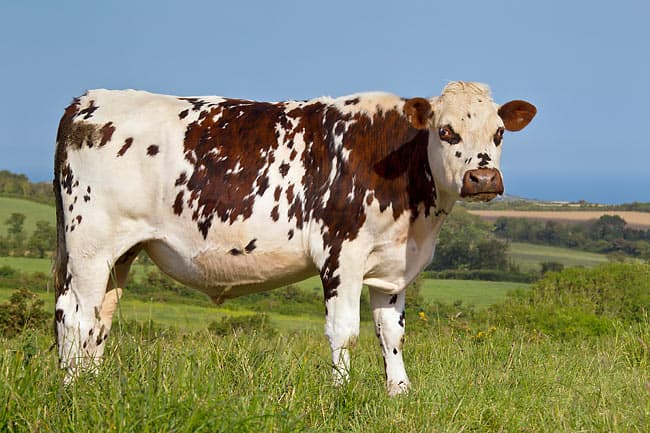
Statistics
- Ultimate grazers that can be used for either beef and dairy production
- Incredible feed converters
- Rich milk for cheese production and good growth rate in calves
- Ideal for dairy crossbreeding
- Fertility
- Calving ease
- Strength
- High percentage yield at slaughter
Portuguese

bovine breed Mirandesa
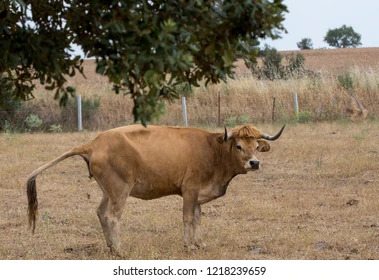
Statistics
- Strong draft cattle, well adapted to limited rough forage and environment
- Quiet temperament
- Remarkable maternal instincts, ensuring the safety of calves from predators
- Calving ease - 100% unaided after first calf (90% if first)
- Fertility - ± 92%
- Longevity - currently 42% of registered cows of this breed are more than 10yrs old and can keep producing till 15 yrs
- Quality beef with even marbling of fat
- Crosses well
Dutch

Friesian cattle breed
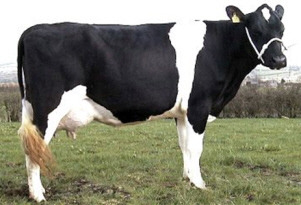
Statistics
- Calve more frequently
- Calve more often in their lifetime
- Need less replacements
- Provide valuable male calves
- Have lower cell counts
- Have higher fat and protein percent
- Versatility
- Quality milk
- High lifetime yields
- High quality lean meat
bovine breed Holstein
(The most popular breed of cattle)
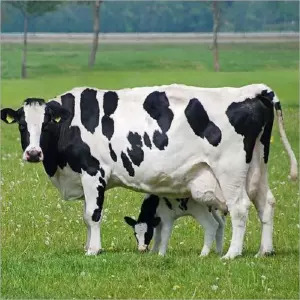
Statistics
Holsteins have the highest milk productions in the world. They have an unequalled genetically anchored achievement ability which has no biological ceiling. Genetic improvements of 1 to 2 percent per year are totally realistic.
They adapt to all management and utilisation systems. They can be stabled, but are equally suitable for grazing. They can be kept on grassland or in mixed farming systems with bi-annual grazing, or be stabled throughout the year. Neither does it matter whether they are kept in high-lying or low-lying area. Not only are Holstein suitable for low-cost farming systems, they are also eminently suitable as dairy industry cows in intensive farming, which requires the stabling of cows.
However, Holsteins, compared to natural breeds, are not as resistant to heat and diseases when in difficult agro-ecological areas. Their reaction to such conditions is a reduced production capacity. Experience has taught that they exhibit divergent adaptation abilities, which should therefore receive attention from a technical point of view when breeding. In the case of cross-breeding with natural breeds the calves show a higher heat tolerance and higher production figures are achieved than in the case of cross-breeding with other cultural breeds.
Holsteins produce vigorous calves distinguished by rapid growth, early maturity and easy care. If they are managed well, they exhibit no fertility problems.
They are good-natured, are easy to handle and can be stabled without any problems. They are also resistant to stress, exhibit a herd mentality and are not solitary animals.
Holsteins are more than just a dairy breed. The animal also contribute to the meat supply worldwide, have a high growth percentage in the fattening sector and produce meat with a fine fibre. In industries aimed exclusively at milk production, they are cross-bred with beef breeds for a better quality veal.
Top producing Holsteins milking twice a day have been known to produce up to 67,914 pounds of milk in 365 days. unexcelled production, greater income over feed costs, unequaled genetic merit, and adaptability to a wide range of environmental conditions Such convincing evidence of genetic superiority has created an active export market for Holstein genetics. Currently, live Holstein females and males and frozen embryos and semen are being exported to more than 50 countries and used extensively to improve foreign food supplies and dairy producer incomes.
Russians

bovine breed Kholmogory

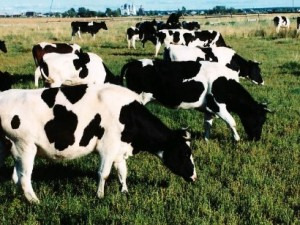
Statistics
The Kholmogory breed was formed in Kholmogory and Archangel districts of Archangel region. It is the oldest and one of the best breeds in the country. Even in the 17th century Kholmogory cattle were noted for their fast rate of growth and high milk production. The development of cattle breeding in the alluvial plain of the Severnaya Dvina river was aided by the available flood plain meadows and pastures with legume-grass mixtures. Excellent pastures in the summer and liberal feeding with high quality hay in winter were the bases for developing such valuable characteristics as the large size, harmonious conformation and high productivity. The local residents attached much importance to the correct methods of raising the young stock by hand nursing not by suckling; they used special methods of feeding, management and milking of the cows. The first selection of the animals was performed by the Kholmogory peasants as far back as 250 years ago. A considerable economic outlet for the Russian cattle products (butter, beef, tallow, leather) in Europe in the 17th and 18th centuries gave a new impetus to the local peasants to develop dairy and beef cattle breeding.
According to the available historical data the Kholmogory breed had been formed long before foreign cattle were imported into Archangel and the adjacent areas. Kholmogory cattle had been exported beyond the boundaries of their initial habitat in 1693, 1713 and 1728 before they were crossed with foreign breeds. Highly productive Kholmogory cattle were used in various parts of the country for improvement of the local cattle. This intensive export resulted in the decline of the Kholmogory cattle husbandry.
Germans

bovine breed vorderwald
Statistics
Vorderwald Cattle are a dual purpose cattle breed adapted, like the related Hinterwald cattle breed, to the rough mountain conditions of the Black Forest in Germany.
They are reputed to be long-lived with strong legs and feet allowing them to graze on the mountains. The head and legs are generally white and the body has red, brown or even black patches or spots. They have forward curved horns.
The so-called “Wald Cattle” was mentioned for the first time in 1544. They were already differentiated between a bigger breed, today’s Vorderwald cattle, and a smaller breed, today’s Hinterwald cattle. A herdbook was established in 1896. After 1960 some was crossbreeding with Ayrshire cattle.
Ottomans

bovine breed ‘Gray Cattle’
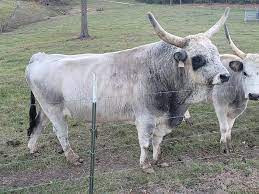
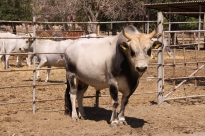
Statistics
Gray Cattle can tolerate a wide range of feedstuffs and have a highly developed digestive system. Some unique characteristics of the Gray Cattle include, the ability to utilize low quality pastures, resistance against diseases and pests, adaptation to extreme environmental conditions, and the ability to live, feed and breed without much human intervention. They spend most of the year as semi-wild animals in free-roaming herds, excluding the regions where heavy winter conditions occur. Their instinct to protect themselves against predators is very high, as well as their maternal instinct. Further, feed and veterinary costs for farmers raising Gray Cattle are negligibly low.
Swedes

bovine breed swedish red-and-white
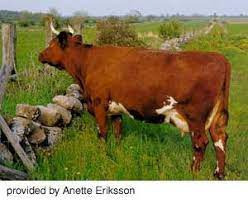
Statistics
These animals are multi purpose cattle breeds. But they are primarily raised as a dairy cattle breed for milk production.
The Swedish Red cattle are a robust and resilient breed of cattle. And they are well known for their longevity, fertility, calving ease and udder health. They are good for many purposes, with some potential in meat production.
But the animals are mainly kept for milk production. The cows on average give about 8000 kg of milk per year. Their milk is of very good quality with a fat content of 4.4 percent and 3.6 percent protein content. Review full breed profile of this breed in the table below.
Spanish

bovine breed morucha
Statistics
It is a rustic and resistant animal, which is raised extensively, and whose main purpose is the production of meat, although some oxen are used as halters. Its size is medium, and its usual coats are uniform black and blue. It has a pigmented muzzle, which is why it is said to be a brown breed, in turn it has great bodily harmony and proportionality.
Anciently, it served as a work animal (draft) and in popular festivities (replacing wild cattle). However, today it is highly valued for its meat aptitude. There are three main types of commercial products:
- Grass or pasture calf: slaughtered with 5 to 9 months and 180-200 kg.
- Yearling: with one year and two herbs with live weights between 250-300 kg.
- Heifer: from two years to two and a half years and weights between 400-450 kg.
bovine breed ‘BON’ ((Spanish)-blanco oereji negro)–(Black-eared white)

Statistics
White-eared cattle, descendants of the cattle brought by Columbus during his second voyage, have survived for almost 500 years in the Colombian tropical coffee-producing areas. In addition to their adaptive capacity, this cattle has shown other characteristics such as: docility, ability to take advantage of poor quality forages, great maternal ability, greater sexual precocity, high fertility, higher productivity in F1 crosses (meat and milk) and marked resistance to ectoparasites. These characteristics, together with recent molecular findings that suggest high genetic variability and resistance to bacterial and viral pathogens, show that this breed, which is currently on the way to extinction, is a carrier of important genetic information that makes it an alternative for production in tropical conditions. The objective of this review is to make a compilation of works carried out with BON cattle; In addition, to show the research perspectives, based on the works currently carried out at the University of Antioquia, in order to demonstrate the genetic potential of this breed, which perhaps has not been able to be expressed due to the management conditions to which it is race has been subdued.
That is all for now. I have some other suggestions that I will add later. I hope you like the idea as much as I do. Thanks! ![]()
![]()
